 |
||
|
||
| ||
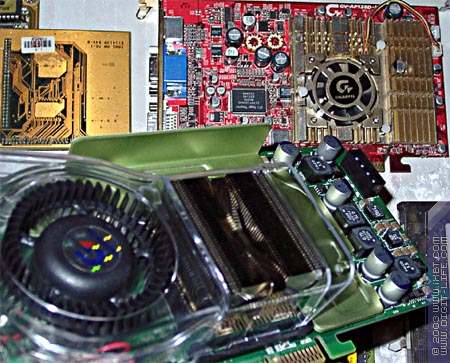 CONTENTS
I wonder if you still remember the Thundra cards from Gigabyte - they were the last graphics cards based on NVIDIA's GPUs (GeForce3 Ti200/500). Yet in Autumn 2001 Gigabyte and NVIDIA had very strained relations aggravated by the release of the ATI RADEON 8500 which signified the end of NVIDIA's monopoly (before that ATI's products had been always weaker, and that attempt to catch up with NVIDIA was a success). Starting from 2002 Gigabyte produced only RADEON based cards. What made the company change its mind and return to NVIDIA based cards a year and a half later? There are a lot of various opinions: the company felt hurt because ATI partnered with ASUSTeK, Gigabyte's competitor, or it just followed ASUSTeK which produced both NVIDIA and ATI based cards, or it could be because ATI didn't supply a sufficient number of chips, or another reason could be ATI's dissatisfaction with poor sales. But they were just rumors. We will hardly guess the real reason, but anyway, now both companies produce graphics cards based both on NVIDIA's and ATI's chips (Gigabyte keeps on making RADEON based cards). So, Gigabyte decided to make a whole line of cards based on NVIDIA's latest GPUs (plus a couple of cards based on NVIDIA's line of the end of 2002). And we are going to look at NVIDIA latest line named GeForce FX. Theoretical materials and reviews of video cards which concern functional properties of the GPU NVIDIA GeForce FX
Today we will test the most powerful graphics card from NVIDIA's camp - GeForce FX 5950 Ultra. Gigabyte hasn't yet developed its own version of such card, and to be the first on the market the company simply bought a batch of NVIDIA reference cards and attached its own sticker to the cooler. Usually Gigabyte's cards ship in big attractive big, and this one is relatively small and says that the card is "Made in Taiwan": 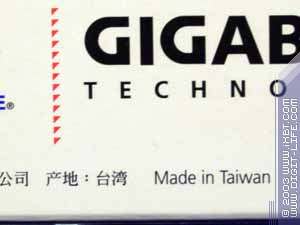 On the card itself you can see the following information: 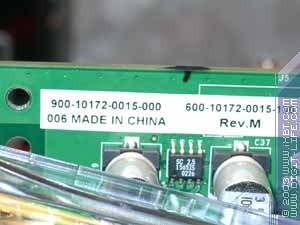 The GV-N595U trade mark is reserved for three cards: with VIVO; with VIVO and Hardware monitoring; and with a TV-out. We had the last card in our lab. Card
Test results: performanceConventional signs: ANISO 8xP - Anisotropic 8x Performance (earlier it was called Balanced), ANISO 8xQ - Anisotropic 8x Quality, ANISO 16xQ - Anisotropic 16x Quality. NVIDIA's optimization policy changes the things and we do not know anymore if there are applications where NVIDIA's anisotropy works to its full capacity. That is why we consider that it's correct to compare ANISO 16xQ (ATI) to ANISO 8xQ (NV). Both have their strong and weak points, but in general they compensate each other. Test applications:
Attention! Since this is a leaked beta version, we won't take into account the cards' scores obtained in this test. Let me remind you that we are going to compare the ForceWare driver
52.16 and 52.70. The Gigabyte GeForce FX 5950 Ultra will be compared
with the Hercules 3D Prophet 9800 XT as it's the fastest RADEON 9800
XT based card for today. Both cards have adequate prices. Quake3 Arena
  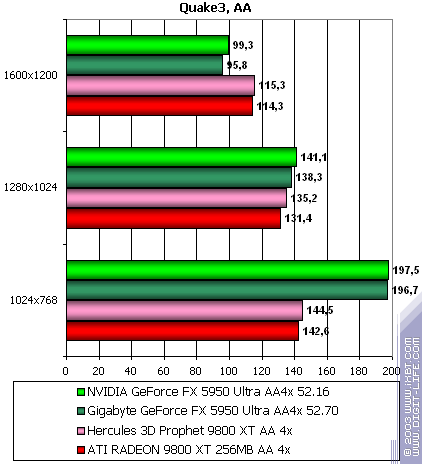  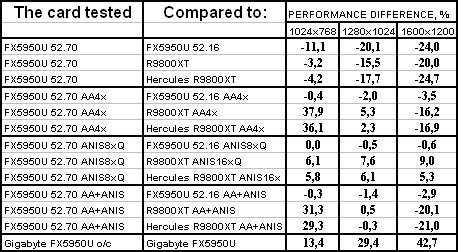 Light modes without AA and anisotropy: on the 52.70 the performance is lower and the FX5950U loses to its competitor. AA enabled: the card wins in 1024x768 but loses in 1600x1200. Anisotropy enabled: the card is just slightly outscores its competitor. AA & anisotropy enabled: there are both victories and defeats
but on average it's a draw game. Serious Sam: The Second Encounter
  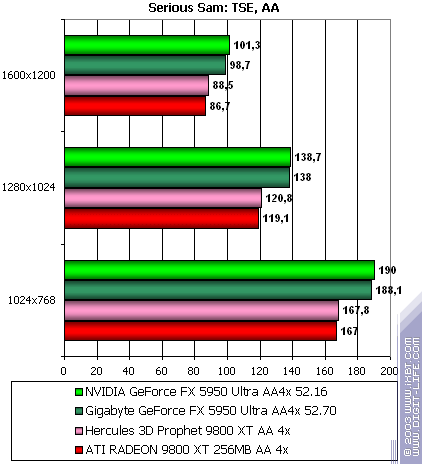 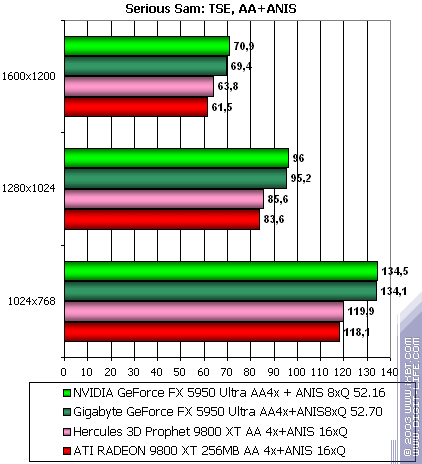  Light modes without AA and anisotropy: the leadership is not convincing. AA enabled: the scores are noticeably higher. Anisotropy enabled: the breakaway of the FX5950 is not great again. AA & anisotropy enabled: the FX5950U wins at the expanse of AA.
Return to Castle Wolfenstein (Multiplayer)
     Light modes without AA and anisotropy: the card falls a little behind. AA enabled: the same Anisotropy enabled: the FX5950U loses again AA & anisotropy enabled: defeat. The card is less speedy on the 52.70 compared to the 52.16. Probably,
they have finally corrected the artefact of lighting of some objects.
Code Creatures
   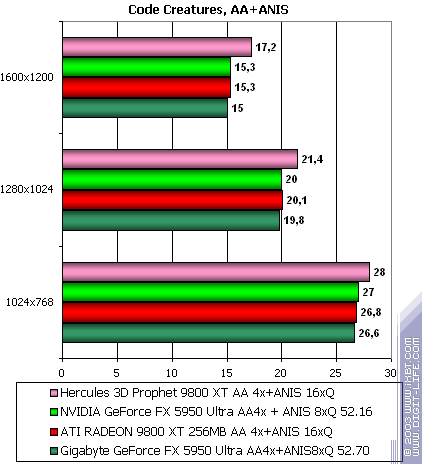 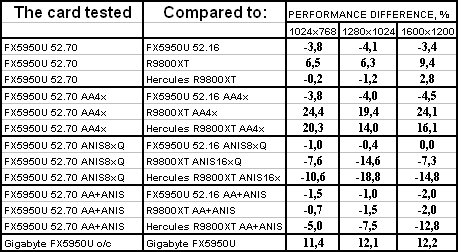 Light modes without AA and anisotropy: parity AA enabled: FX5950U keeps the lead Anisotropy enabled: the victory turns into a defeat. AA & anisotropy enabled: parity. Unreal Tournament 2003
  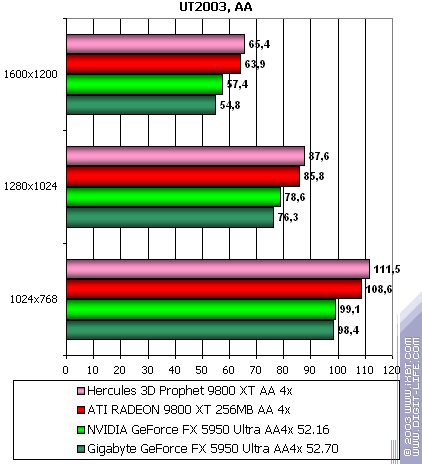  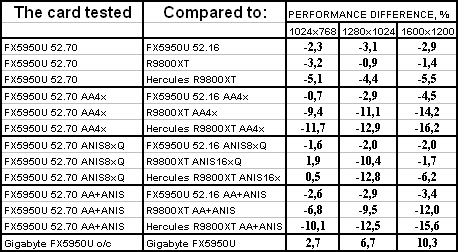 Light modes without AA and anisotropy: it falls a little behind, though generally it looks like parity. AA enabled: the card looks even worse. Anisotropy enabled: the FX5950U loses again AA & anisotropy enabled: defeat. Unreal II: The Awakening
    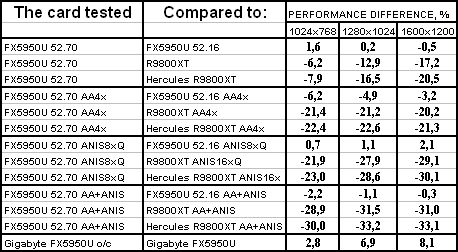 Light modes without AA and anisotropy: defeat AA enabled: the same Anisotropy enabled: the same AA & anisotropy enabled: fiasco. RightMark 3D
  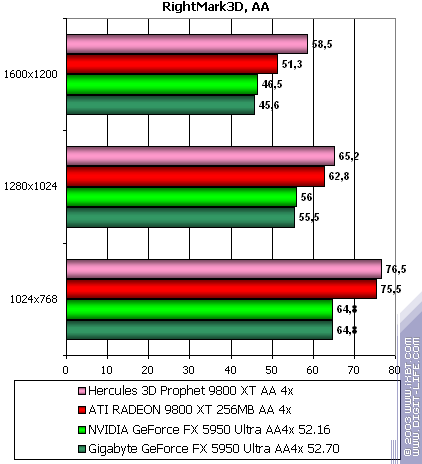  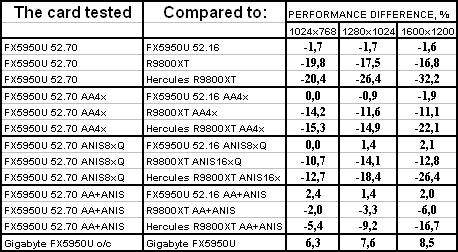 Well, the test uses a lot of shaders, and the Hercules R9800XT easily
wins. TR:AoD, Paris5_4 DEMO
 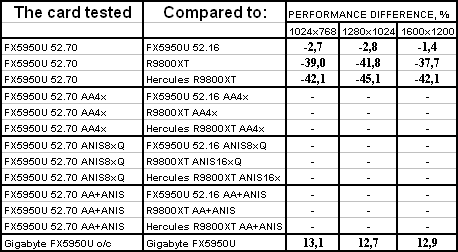 The shaders again help the RADEON 9800 XT gain the leadership. TR:AoD, Paris1c DEMO
  The same. TR:AoD, Paris2g DEMO
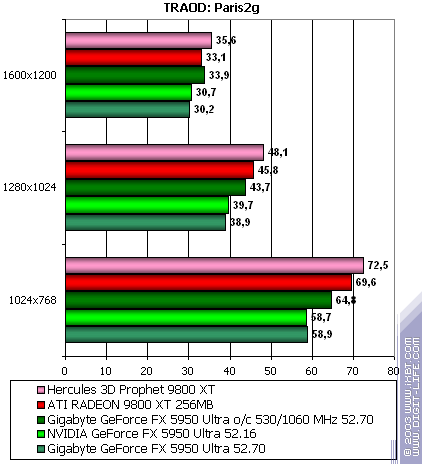 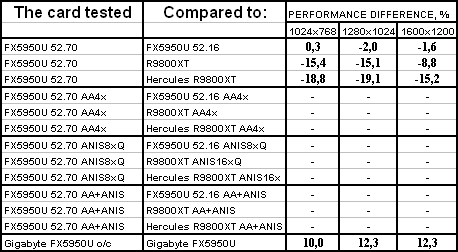 This scene uses much fewer shaders, that is why the NV38 comes very
close to the 9800XT. HALO: Combat Evolved
 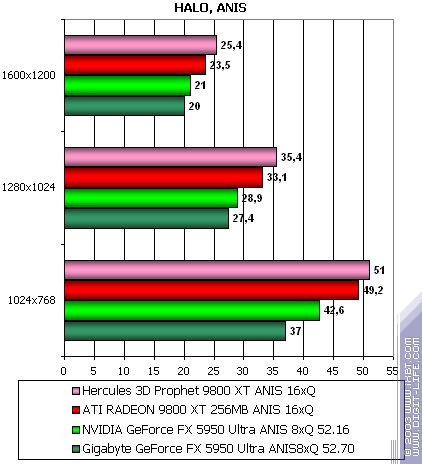  Light modes without AA and anisotropy: the card is a bit behind its competitor. This game doesn't support AA. Anisotropy enabled: the Hercules R9800XT is far ahead! Half-Life2 (beta): ixbt07 demo
 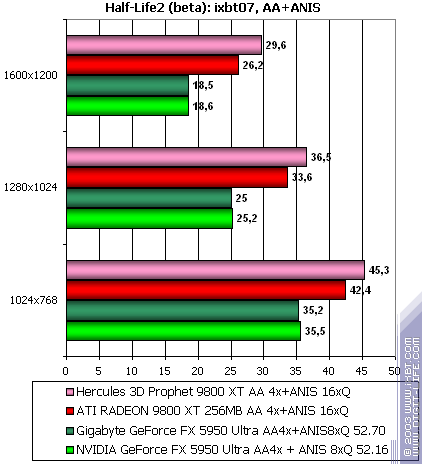  Since the game is unfinished, the data obtained are not analyzed.
Half-Life2 (beta): coast demo
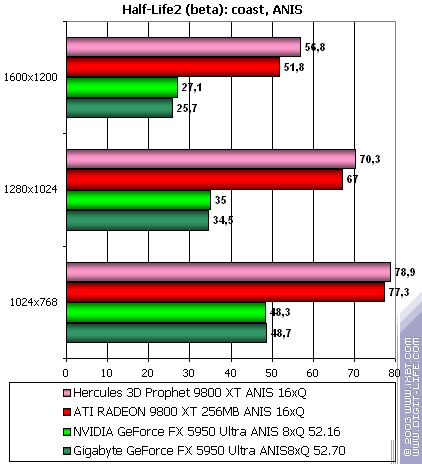  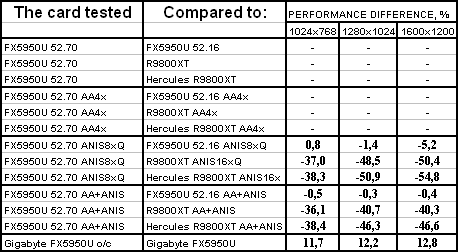
Splinter Cell
  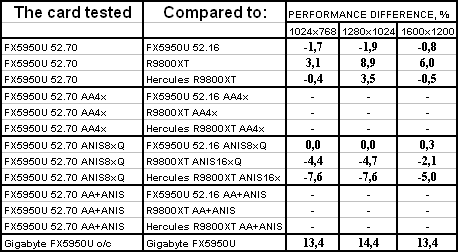 Light modes without AA and anisotropy: parity AA doesn't work here. Anisotropy enabled: the Hercules RADEON 9800 XT keeps the lead. ConclusionThe performance doesn't speed up with the driver version 52.70, sometimes it even falls down; however, the developers removed the bug in the RtCW. As to the GeForce FX 5950 Ultra card, this is just a reference solution: it wins and loses right the same way. In the shader tests the NVIDIA card mostly loses the battle. The price will be a determining factor! If it's $70-80 cheaper than the top RADEON 9800 XT, the GeForce FX 5950 Ultra can be a success (but remember that the cooler is pretty bulky and not that quiet). The experience shows that such boxes will be further used for Gigabyte's own cards. I don't know how they are going to look and what features they are going to have. It looks similar to the situation with the GeForce FX 5900 Ultra based cards from Leadtek and MSI as the first lots also contained only reference cards. Only the next lots contained the two-cooler cards from Leadtek and bright red MSI's cards with copper sun-like coolers. In our 3Digest you can find
full comparison characteristics for video cards of this and other
classes. 
Andrey Vorobiev (anvakams@ixbt.com)
Write a comment below. No registration needed!
|
Platform · Video · Multimedia · Mobile · Other || About us & Privacy policy · Twitter · Facebook Copyright © Byrds Research & Publishing, Ltd., 1997–2011. All rights reserved. | ||||||||||||||||||||||||||||||||||||||||||||||||||||||||||||||||